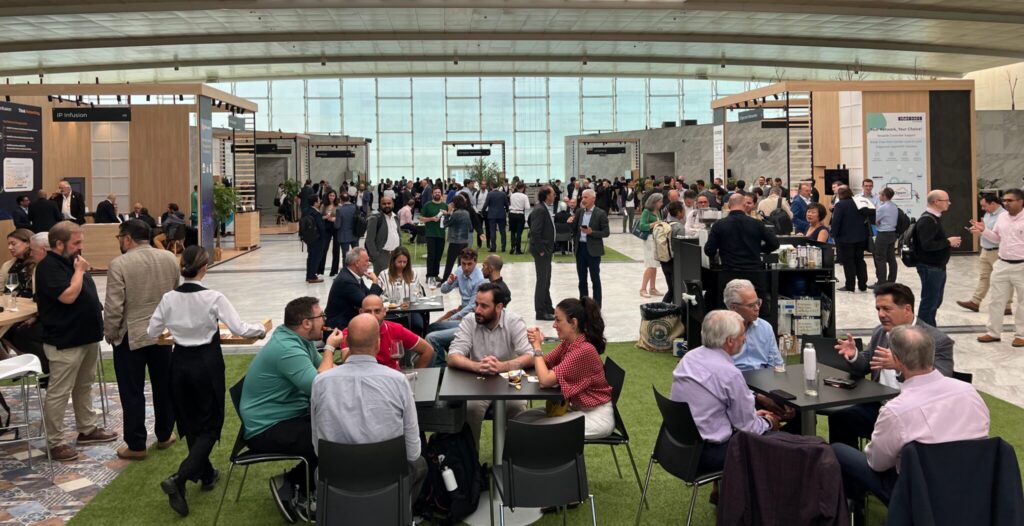FYUZ2023 had more going on than it might have seemed. Compared to last year, there was no vegetable orchestra, no olive-flavored bubbles, no “celebrity” speakers. And no Tareq Amin. On the other hand, talk of metaverse didn’t dominate, network slicing wasn’t the answer to all of telecoms’ prayers and FYUZ was largely a GenAI-free zone. Which left…?
Which left …the nuts and bolts of open and disaggregated networks. Open RAN, for sure, remains a central pillar of the event, but there was more on open transport, open WiFi, open LAN and some useful exposure for neutral hosts (formerly known as NaaS – the TIP working group has been essentially renamed).
There were a few downsides – the programming was a little patchy in places. Old-fashioned plenary-type sessions were too long; “keynote panels” can quickly lose energy. Slightly too many competing sessions (perhaps a nice problem to have, but some promised more than they delivered). A whole-day host/MC would have been useful to help with orientation and reinforce each day’s programming and takeaways. But these are minor points – and offered here as constructive input to make FYUZ 2024 even more successful.
On the upside, FYUZ is still a unique event. There isn’t another telecom tradeshow where “open” gets as much of a focus. And so the show sponsors deserve credit for their commitment to the Open cause, in its multiple guises: open network software on whitebox hardware (IPInfusion, DriveNets), the boxes themselves (EdgeCore, Ufispace), platforms (Red Hat, VMware, Wind River), orchestrators (Accelleran, CapGemini, Fujitsu), test & validation (Spirent, Keysight…), open RAN software and solution providers (Rakuten Symphony, NTT DoCoMo, Mavenir), systems integration (Amdocs, Fujitsu) out-and-out disruptors (Cohere Technologies) – as well of course as the companies increasingly active at the very foundations of it all: Intel, Arm, AMD, Nvidia, Marvell… And it was good to see Parallel Wireless return to a tradeshow floor: welcome back.

Sponsors…with at least a couple of big names noticeably absent…maybe next year…
If footfall seemed light for the venue, vendors we spoke to seemed satisfied with their ROI at the event. At an Open-themed event, partner discussions are every bit as useful (well, almost) as prospective customer discussions (partner + customer meetings, as several vendors seemed to be running, can move the sales process along nicely and cost-efficiently).

FYUZ has a spacious and relaxed yet workmanlike vibe.
And to be fair, the Open cause is being championed by at least some senior telecom executives, who showed up to (re)pledge their allegiance: Iago Tenorio, Andrea Dona and Francisco Martin Pignatelli from Vodafone Group, Rob Soni from AT&T, Kaniz Mahdi from Deutsche Telekom, Sidd Chenumolu at Dish, Nastasi Karaiskos from Rakuten, Sadayuki Abeta at NTT DoCoMo, Laurent Leboucher at Orange, Juan Carlos Garcia from Telefonica, among others. Kudos to TIP for such an impressive showing of telco execs.
It wasn’t possible to get to every session at the event (though TIP has now published most of the content). But based on what we did see, here were our key takeaways:
- Open RAN has gone mainstream. Only Huawei and ZTE truly sit outside the Open RAN tent (even if those inside don’t agree on everything).
- Vodafone’s open RAN progress is steady – and now entering mass-scale rollout (with the promise of significant spend in the near term).
- The results are there. There is growing evidence that Open RAN based networks are as reliable, performant, and secure as their legacy equivalent – and lower cost to deploy and operate. But that will not be enough to accelerate Open RAN adoption.
- Progress has slowed. There’s no doubting the enthusiasm of the Open RAN pioneer community and progress made within it, but the next wave has yet to arrive.
- Certification is the next mountain to climb. Arguably at “peak labs” already, the cause of Open RAN must now be served by a shared, regularized process with a meaningful saving in cost and effort over individual vendor or operator validation.
- Open RAN needs a change to the buying model. The technology is working well enough – but the conventional procurement model is not yet aligned.
- It’s all about ecosystems. Ecosystems address a range of political, organizational as well as technical concerns. For the next wave of Open RAN converts, examples of functioning ecosystems are essential.
- Innovation that exploits Open RAN is nascent. With the focus on parity to date, very little has been done that would result in an appreciably distinct end-user experience.
- “Open” is exploring new niches. Below the radar of high-profile macro deployments, Open-based networks are finding viable new market niches.
We cover these points in a much more thorough and detailed analysis of vendor and operator comments from the event in a 13-page Research Note.
Fyuz 2023 was a unique opportunity to survey the multiple dimensions and dynamics within the Open RAN, and wider Open movement. As such it deserves to be a regular fixture in the calendar for anyone with an interest in new thinking in telecom – not only about RAN, but also in areas such as business models, business processes and automation.
Our on-site team go into more detail for our research subscribers in a separate Research Note.